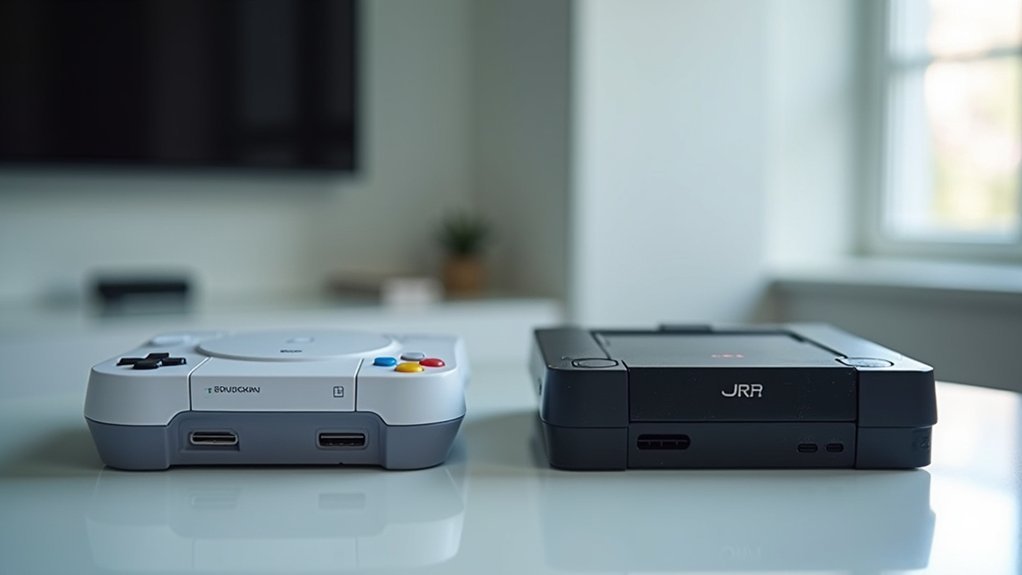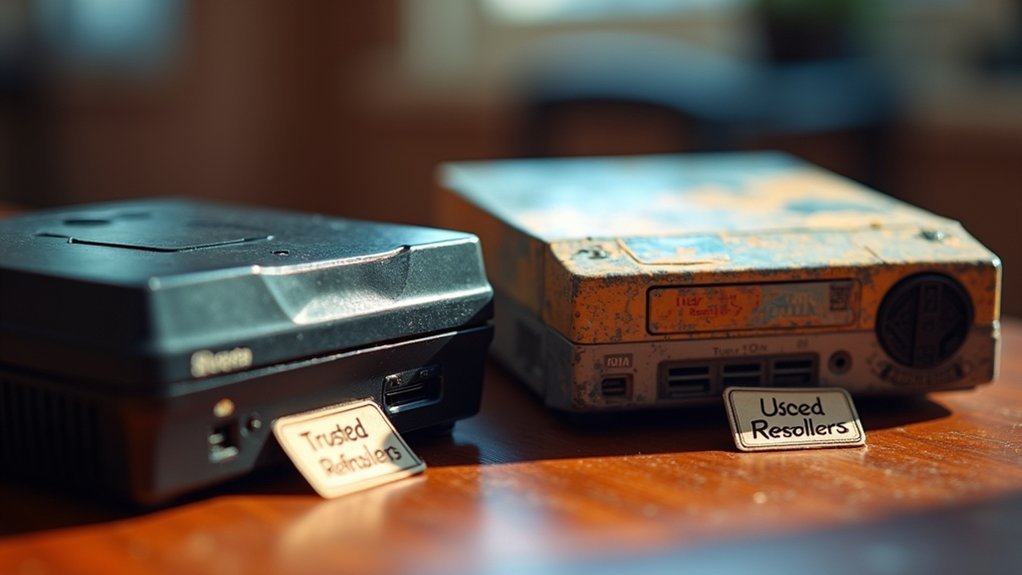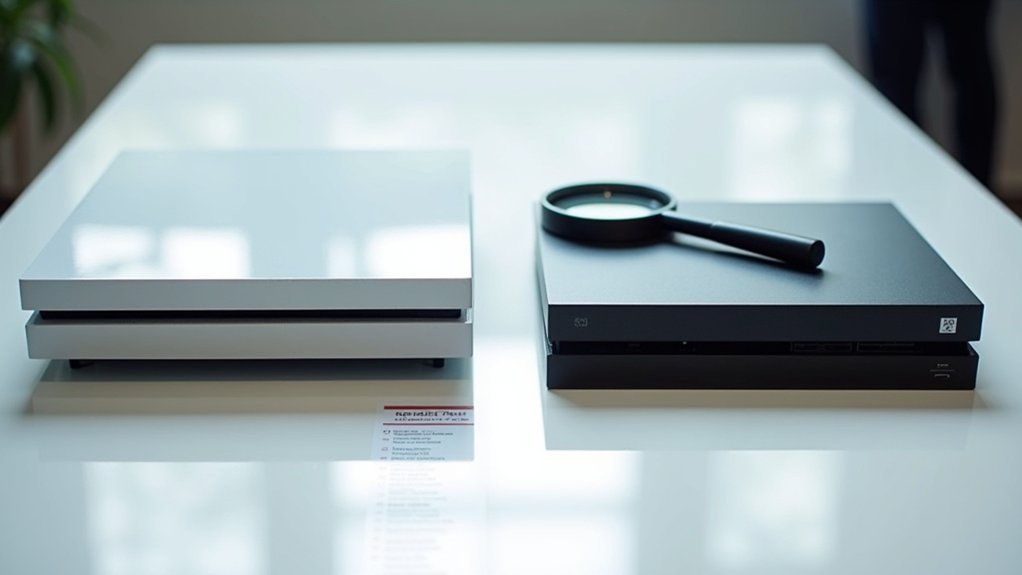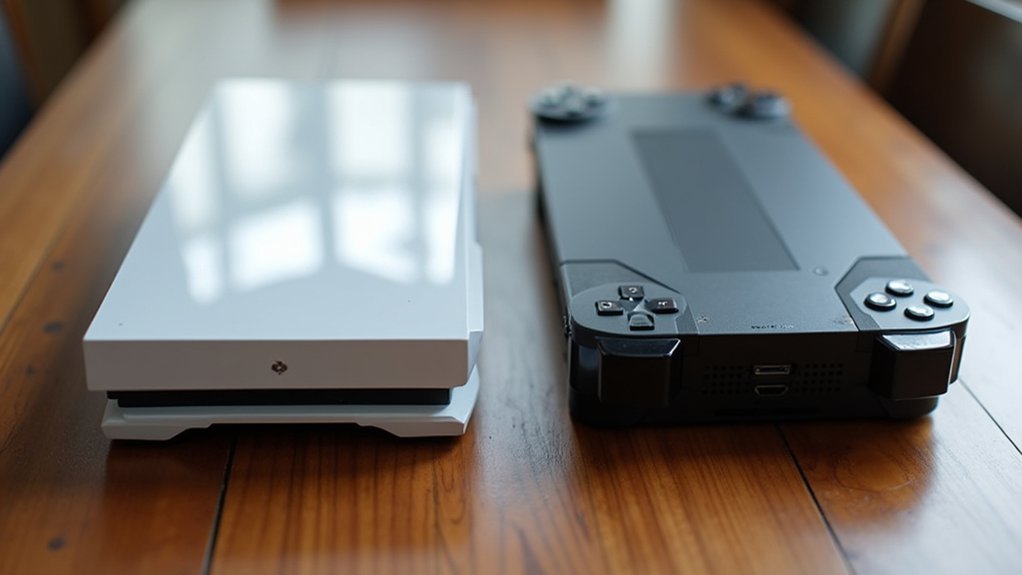You’ll find refurbished consoles offer professional testing, repairs, and 90-day to 1-year warranties, while used consoles are sold as-is with minimal guarantees. Refurbished units undergo thorough inspections and cleaning, ensuring higher reliability than used alternatives with unknown wear patterns. Price-wise, refurbished consoles cost 30-50% less than new, while used prices vary by condition. Buy from trusted retailers like Amazon, Best Buy, or GameStop for quality assurance. These seven key distinctions will help you make the smartest purchase decision.
Understanding the Key Differences Between Refurbished and Used Consoles

When you’re shopping for a gaming console on a budget, understanding the distinction between refurbished and used units can save you money and frustration.
Refurbished consoles undergo professional repairs and testing to restore them to full working condition, while used consoles are sold as-is without quality guarantees.
You’ll find refurbished units come with warranties ranging from 90 days to a year, providing security that used consoles typically lack.
The refurbishment process includes thorough inspections, cleaning, and component replacements, ensuring higher reliability than used alternatives that vary in condition.
Reputable retailers or manufacturers sell refurbished consoles with quality assurance, whereas used consoles from individuals or unregulated outlets carry greater risk of hidden defects and performance issues.
Warranty Coverage and Protection Plans Comparison
When you’re choosing between refurbished and used consoles, warranty coverage becomes a critical factor that’ll impact your purchase decision.
You’ll find significant differences in warranty length, with refurbished consoles typically offering 90 days to a year of protection while used consoles often come with no warranty at all.
Understanding these coverage variations and available protection plans will help you make an informed choice that protects your investment.
Warranty Length Differences
One of the most significant advantages you’ll find with refurbished consoles is their warranty coverage, which typically spans 90 days to a full year compared to the minimal or nonexistent protection offered with used systems.
| Console Type | Warranty Length | Support Coverage |
|---|---|---|
| Manufacturer Refurbished | 6-12 months | Full repair/replacement |
| Third-party Refurbished | 90 days-6 months | Limited support |
| Used Consoles | 0-30 days | As-is condition |
This warranty difference creates substantial value when you’re investing in gaming hardware. Manufacturer-refurbished units offer the longest protection periods with extensive customer support, while used consoles often leave you vulnerable to immediate failures without recourse. The extended warranty coverage on refurbished systems means you’re getting peace of mind that’s simply unavailable with most used purchases.
Coverage Scope Comparison
Beyond warranty duration, the actual coverage scope reveals dramatic differences between refurbished and used console protection plans.
When you buy refurbished consoles, you’ll typically receive thorough warranty coverage that includes hardware defects, component failures, and functionality issues. The refurbishing entity backs these guarantees with replacement or repair services, ensuring you’re protected against manufacturing problems.
Used consoles rarely offer meaningful warranty protection. You’re fundamentally buying “as-is” with minimal recourse if problems arise.
The coverage scope for refurbished units often extends to parts, labor, and sometimes even shipping costs for repairs. This thorough protection contrasts sharply with used console purchases, where you’ll shoulder the full financial burden of any repairs or replacements needed after purchase.
Protection Plan Options
While warranty coverage forms the foundation of console protection, additional protection plans can greatly expand your safety net beyond standard coverage. You’ll find various options when purchasing refurbished units or used consoles, each offering different levels of protection.
| Protection Feature | Refurbished | Used |
|---|---|---|
| Standard Warranty | 90 days – 1 year | Usually none |
| Extended Plans | Often available | Limited options |
| Manufacturing Defects | Typically covered | Rarely covered |
| Accident Protection | May be offered | Seller-dependent |
| Return Policy | Usually included | Varies widely |
When evaluating protection plans, you should compare what each seller offers. Some retailers provide extensive coverage that includes accidental damage, while others focus solely on manufacturing defects. Always review terms and conditions carefully to understand limitations and exclusions before making your purchase decision.
Quality Assurance and Testing Standards
When you’re comparing refurbished and used consoles, you’ll find significant differences in quality assurance standards.
Refurbished units go through professional testing protocols that include thorough diagnostics, repairs, and performance verification before they reach your hands.
Used consoles typically don’t receive this level of scrutiny, which directly impacts the warranty coverage you’ll receive with each option.
Professional Testing Protocols
As you evaluate gaming console options, understanding the testing protocols becomes essential for making an informed decision. Refurbished consoles undergo extensive examination procedures that rigorously tested each component’s functionality. These protocols include systematic hardware checks, software diagnostics, and performance evaluations that verify every system meets established quality benchmarks.
Professional refurbishers follow standardized testing guidelines that examine controllers, ports, disc drives, and internal components. They’ll replace defective parts and conduct thorough cleaning processes before certification. Handheld systems receive complete battery reconditioning and screen inspections.
Used consoles lack these professional evaluations, resulting in variable quality depending on previous ownership care. Without systematic testing, you’re gambling on functionality.
Refurbished units provide documented verification that systems operate properly, while used purchases offer no performance guarantees or quality assurance protocols.
Warranty Coverage Differences
Beyond these rigorous testing procedures, warranty coverage creates the most substantial protection gap between refurbished and used consoles.
When you purchase refurbished consoles, you’ll typically receive warranties ranging from 90 days to a full year from the refurbishing entity. This warranty coverage protects you against defects and malfunctions, providing quality assurance for your investment.
Used consoles, however, offer little to no warranty protection, leaving you vulnerable to potential failures immediately after purchase. You’re fundamentally buying these systems as-is, with no recourse if problems arise.
Reputable refurbishers stand behind their work by replacing faulty components and providing necessary repairs during the refurbishment process. This thorough approach, combined with warranty coverage, offers you considerably more peace of mind than the unpredictable nature of used console purchases.
Where to Buy: Trusted Sources for Each Console Type

Since choosing the right retailer can make or break your console purchase, you’ll want to focus on established sources that offer buyer protection and quality assurance.
For refurbished systems, major online retailers like Amazon and Best Buy provide warranties and quality guarantees, making them ideal trusted sources. GameStop stands out for its rigorous testing and cleaning processes on refurbished units.
When hunting for used consoles, retailers like GAME and MusicMagpie offer pre-owned deals, though you’ll need to carefully inspect condition ratings.
Gaming deal aggregator websites help you compare prices across multiple platforms.
Always verify seller reputation and read customer reviews before purchasing. These steps guarantee you’re buying from legitimate sources that’ll honor their commitments if issues arise.
Price Evaluation and Value Assessment Strategies
Once you’ve identified trusted retailers, your next step involves calculating the actual value you’re getting for your money.
Start your price evaluation by comparing refurbished console costs against current new console prices. You’ll typically find savings of 30-50% on refurbished units, while used console prices vary dramatically based on condition and seller reputation.
Factor warranty coverage into your assessment. Refurbished consoles often include 90-day to one-year warranties, adding significant value compared to used systems with minimal protection.
Consider that refurbished units undergo professional testing and repairs, ensuring reliable performance that justifies higher prices than untested used alternatives.
Don’t overlook discontinued models available through refurbished channels, which offer collectors unique value unavailable elsewhere in the market.
Inspection Checklist Upon Delivery

When your refurbished console arrives, you’ll need to conduct a thorough inspection before the return window closes. Your inspection checklist should cover both cosmetic and functional elements to guarantee you’ve received quality merchandise.
| Inspection Area | What to Check |
|---|---|
| Physical Condition | Examine for scratches, dents, or cosmetic damage |
| Functionality | Test power, connectivity, and all operational features |
| Documentation | Verify warranty card and refurbishment process details |
| Accessories | Confirm controllers and cables are included and functional |
| System Reset | Confirm factory settings with no previous user data |
Test every component to confirm everything’s in working order. Missing accessories are common issues with refurbished purchases, so verify completeness immediately. This systematic approach protects your investment and guarantees satisfaction.
Long-Term Reliability and Performance Expectations
The reliability gap between refurbished and used consoles becomes most apparent over extended ownership periods.
When you’re investing in gaming hardware, refurbished units consistently outperform used alternatives in long-term reliability metrics. The professional restoration process guarantees components meet manufacturer specifications, while used consoles carry unknown wear patterns that can trigger unexpected failures.
You’ll experience more predictable performance with refurbished systems because they’ve undergone thorough testing protocols.
Used consoles often develop issues months after purchase, leaving you without gaming access during critical moments.
Key reliability advantages of refurbished consoles:
- Warranty protection covering 90 days to one year
- Professional component replacement and upgrades
- Full functionality inspection before sale
- Rigorous testing meeting performance standards
- Addressed defects versus undisclosed used console problems
Frequently Asked Questions
What’s the Difference Between Refurbished and Pre-Owned Consoles?
Refurbished consoles undergo professional testing, repairs, and restoration with warranties, while pre-owned consoles are simply used devices that may lack thorough inspections and typically don’t include warranty coverage.
Is It Better to Buy Refurbished or Used?
You should buy refurbished over used because you’ll get better reliability, warranty protection, and professional testing. Refurbished consoles offer more security and consistent quality than unpredictable used options.
Is Refurbished Different From Second-Hand?
Yes, refurbished differs considerably from second-hand. You’ll get professionally tested, repaired consoles with warranties when buying refurbished, while second-hand items haven’t undergone quality control or restoration processes.
Is Pre-Owned or Refurbished Better Best Buy?
You’ll find refurbished consoles are better at Best Buy since they’re professionally tested, come with warranties, and include customer support, while pre-owned options may lack these protections and quality assurances.




Leave a Reply